Please click here to help David McMurrey pay for web hosting:
Donate any small amount you can !
Online Technical Writing will remain free.
Be sure to check out the examples.
Some Preliminaries
As you get started, make sure you understand the definition we're using for proposals. Also, if you are taking a technical writing course, make sure you understand the proposal assignment—not to write just any proposal but one that, at least in part, proposes to write something.
Real proposals. To begin planning a proposal, remember the basic definition: a proposal is an offer or bid to do a certain project for someone. Proposals may contain other elements—technical background, recommendations, results of surveys, information about feasibility, and so on. But what makes a proposal a proposal is that it asks the audience to approve, fund, or grant permission to do the proposed project.
If you plan to be a consultant or run your own business, written proposals may be one of your most important tools for bringing in business. And, if you work for a government agency, nonprofit organization, or a large corporation, the proposal can be a valuable tool for initiating projects that benefit the organization or you the employee-proposer (and usually both).
A proposal should contain information that would enable the audience of that proposal to decide whether to approve the project, to approve or hire you to do the work, or both. To write a successful proposal, put yourself in the place of your audience—the recipient of the proposal—and think about what sorts of information that person would need to feel confident having you do the project.
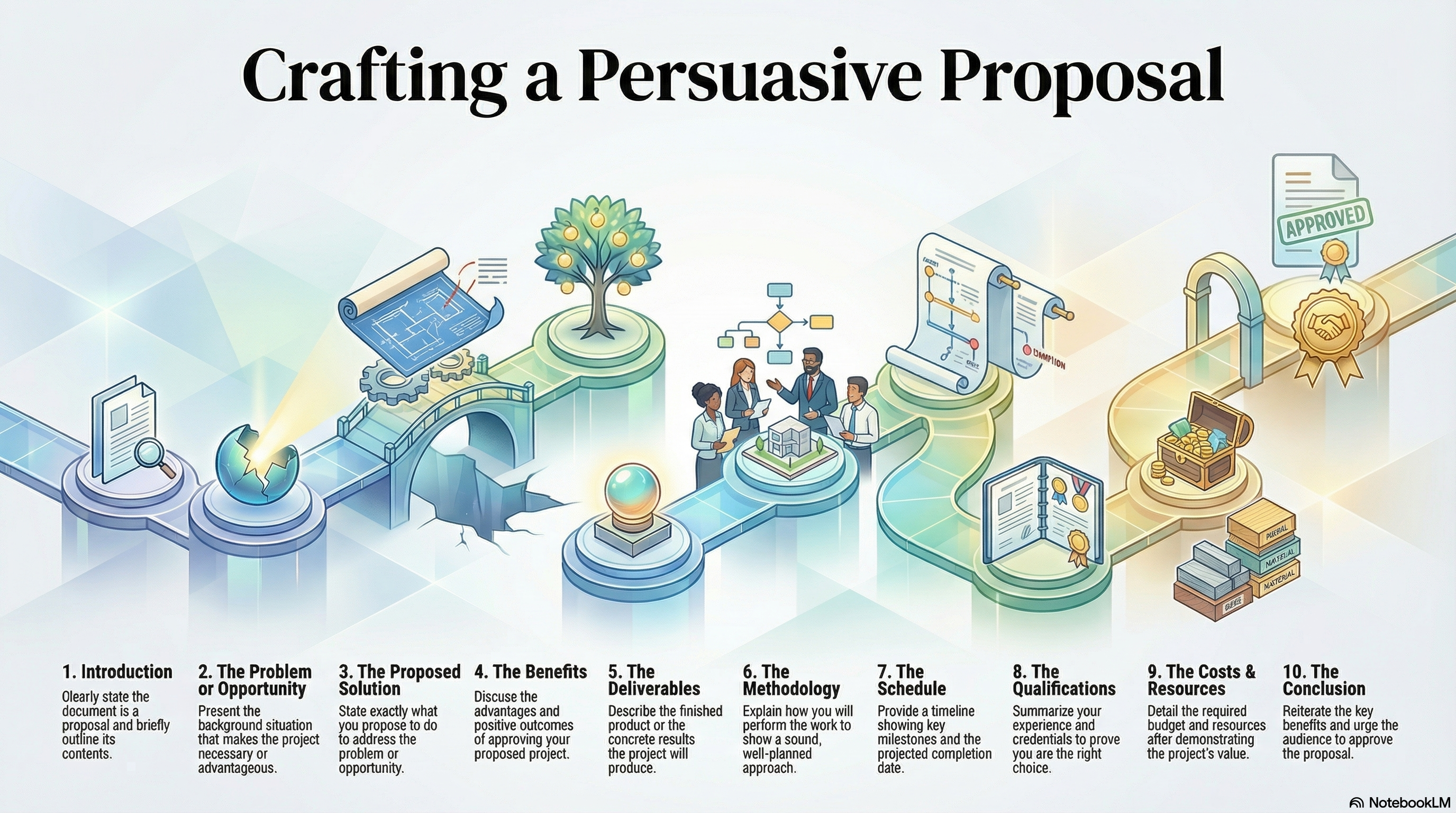 NotebookLM-generated infographic of this chapter
NotebookLM-generated infographic of this chapter
Types of proposals. Consider the situations in which proposals occur. A company may send out a public announcement requesting proposals for a specific project. This public announcement—called a request for proposals (RFP)—could be issued through newspapers, trade journals, Chamber of Commerce channels, or individual letters. Firms or individuals interested in the project would then write proposals in which they summarize their qualifications, project schedules and costs, and discuss their approach to the project. The recipient of all these proposals would then evaluate them, select the best candidate, and then work up a contract.
But proposals also come about much less formally. Imagine that you are interested in doing a project at work (for example, investigating the merits of bringing in some new technology to increase productivity). Imagine that you visited with your supervisor and tried to convince her of this. She might respond by saying, "Write me a proposal and I'll present it to upper management." As you can see from these examples, proposals can be divided into several categories:
- Internal, external proposals. A proposal to someone within your organization (a business, a government agency, etc.) is an internal proposal. With internal proposals, you may not have to include certain sections (such as qualifications) or as much information in them. An external proposal is one written from one separate, independent organization or individual to another such entity. The typical example is the independent consultant proposing to do a project for another firm.
- Solicited, unsolicited proposals. A solicited proposal is one in which the recipient has requested the proposal. Typically, a company will send out requests for proposals (RFPs) through the mail or publish them in some news source. But proposals can be solicited on a very local level: for example, you could be explaining to your boss what a great thing it would be to install a new technology in the office; your boss might get interested and ask you to write up a proposal that offered to do a formal study of the idea. Unsolicited proposals are those in which the recipient has not requested proposals. With unsolicited proposals, you sometimes must convince the recipient that a problem or need exists before you can begin the main part of the proposal.
- "Great idea" (non)proposals. Imagine that you have a terrific idea for installing new technology at your work. You write an explanation how it works and why it's so great and then end by urging management to go for it. Is that a proposal? No—not in this context. It's more like a feasibility report, which studies the merits of a project and then recommends for or against it. All it would take to make this document a proposal would be to add elements that ask management for approval and for you to go ahead with the project.
Other options for the proposal assignment. It may be that you cannot force your report-project plans into the proposal context. Another option is to write an academic proposal—you address it to your instructor and make no pretense of realism. See an example of this type of proposal.
Typical Scenarios for the Proposal
It gets a bit tricky dreaming up a good technical report project and then a proposal project that proposes at least in part to write that report. Here are some ideas:
- Imagine that a nonprofit organization focused on a particular issue wants an expert consultant to write a handbook or guide for its membership. This document will present information on the issue in a way that the members can understand.
- Imagine that a company has some sort of problem or wants to make some sort of improvement. It sends out a request for proposals; you receive one and respond with a proposal. You offer to come in, investigate, interview, make recommendations—and present it all in the form of a report.
- Some organization wants a seminar in your expertise. You write a proposal to give the seminar—included in the package deal is a guide or handbook that the people attending the seminar will receive.
- You want to write a business prospectus for the kind of business you intend to start up. Imagine that you want a top-quality prospectus and don't have the time or expertise to prepare one; therefore, you send out request for proposals to professional consultants. You change hats and pretend you are Business Startup Consultants, Inc., and send your other self a proposal to do the job. Your proposal accepted, you (as Business Startup Consultants, Inc.) write the prospectus.
- Some agency has just started using a fancy desktop-publishing system, but the documentation is giving people fits. You receive a request for proposals from this agency to write some sort of simplified guide or startup guide.
Consider using this planning guide for report-oriented proposals.
Requests for Proposals (RFP)
Consider the situations in which proposals occur. A company may send out a public announcement requesting proposals for a specific project. This public announcement—called a request for proposals (RFP)—could be issued through newspapers, trade journals, Chamber of Commerce channels, or individual letters. Firms or individuals interested in the project would then write proposals in which they summarize their qualifications, project schedules and costs, and discuss their approach to the project. The recipient of all these proposals would then evaluate them, select the best candidate, and then work up a contract.
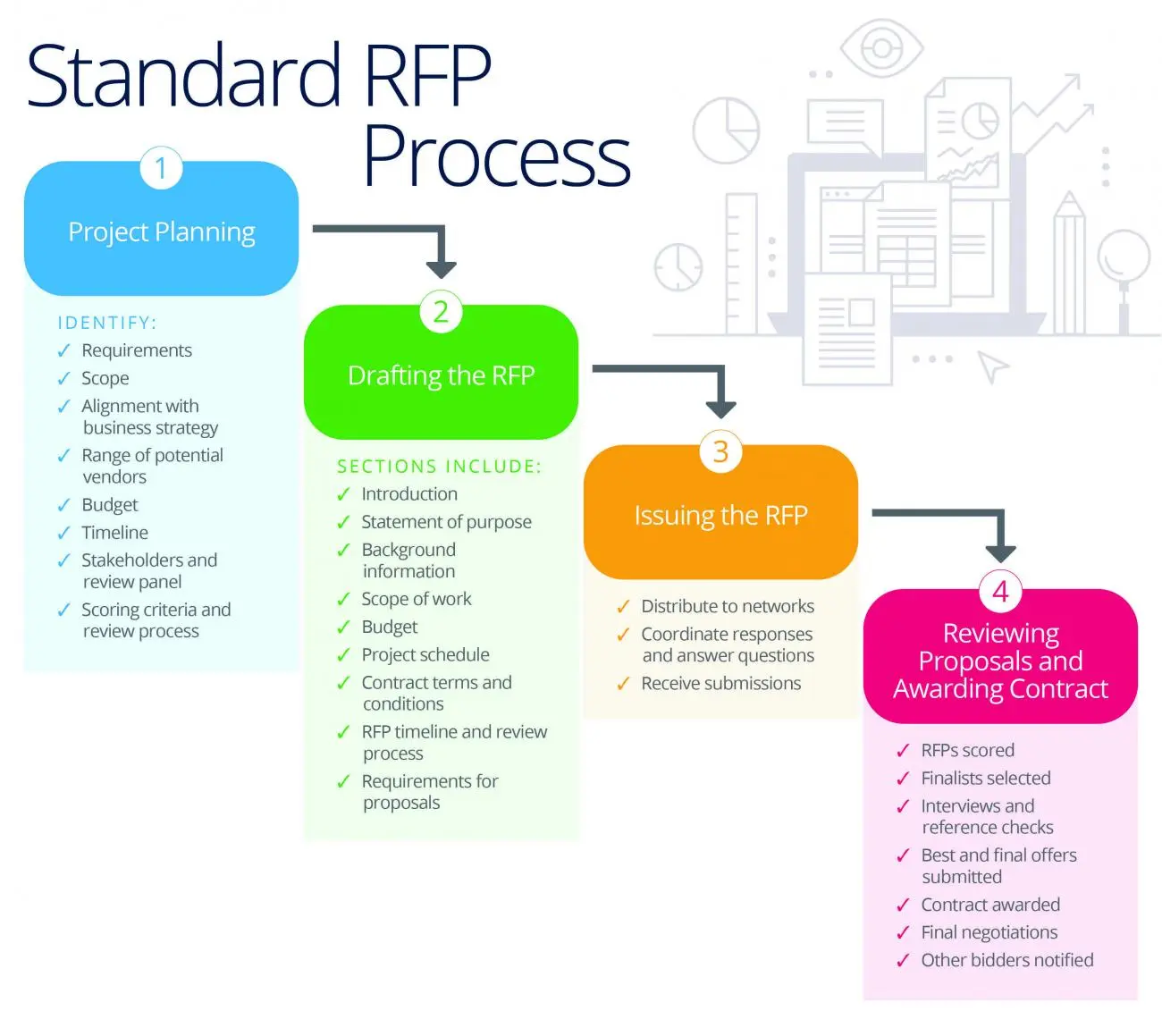
Source: smartsheet.com
But proposals come about much less formally—and so do RFPs. Imagine that you are interested in doing a project at work (for example, investigating the merits of bringing in some new technology to increase productivity). Imagine that you visited with your supervisor and tried to convince her of this. She might respond by saying, "Write me a proposal and I'll present it to upper management." Or your supervisor could initiate the project, suggesting or directing an informal RFP To you.
Explore the examples in the resources below to see how RFPs are organized, the language they use to describe their product and their business, and the information they seek from potential bidders:
- RFP Database lists requests for proposals, bid opportunities, and the latest project offerings in the U.S., Canada, and the European Union. Categories include business services, construction, creative, health and human services, professional services, research and development, supplies and technology.
- Professional organizations, such as the Public Relations Society of America, list RFPs relevant to that sector.
- RFP Zone lists public sector RFPs from U.S., Canada, and the UK in a free subscription service.
- Most federal request for proposals are listed in the Federal Business Opportunities database.
- FindRFP lists federal, state and local government RFPs and bidding opportunities.
- Where nonprofit data meets decision makers. Free service that publishes RFPs for nonprofits and foundations, candid.org
—Information adapted with opermission from smartsheet.com
Common Sections in Proposals
The following is a review of the sections you'll commonly find in proposals. Don't assume that each one of them has to be in the actual proposal you write, nor that they have to be in the order they are presented here—plus you may discover that other kinds of information not mentioned here must be included in your particular proposal.
As you read the following on common sections in proposals, check out the example proposals listed at the start of this chapter. Not all of the sections discussed in the following will show up in the examples, but most will.
Introduction. Plan the introduction to your proposal carefully. Make sure it does all of the following things (but not necessarily in this order) that apply to your particular proposal:
- Indicate that the document to follow is a proposal.
- Refer to some previous contact with the recipient of the proposal or to your source of information about the project.
- Find one brief motivating statement that will encourage the recipient to read on and to consider doing the project (if it's an unsolicited or competitive proposal) and you to do the project.
- Give an overview of the contents of the proposal.
Take a look at the introductions in the first two example proposals listed at the beginning of this chapter, and try to identify these elements.
Background on the problem, opportunity, or situation. Often occurring just after the introduction, the background section discusses what has brought about the need for the project—what problem, what opportunity there is for improving things, what the basic situation is. For example, management of a chain of daycare centers may need to ensure that all employees know CPR (maybe new state guidelines have been enacted about CPR certification). An owner of pine timber land in east Texas may want to get the land productive of saleable timber without destroying the ecology.
It's true that the audience of the proposal may know the problem very well, in which case this section might not be needed. Writing the background section still might be useful, however, in demonstrating your particular view of the problem. And, if the the proposal is unsolicited, a background section is almost a requirement—you will probably need to convince the audience that the problem or opportunity exists and that it should be addressed.
Benefits and feasibility of the proposed project. Most proposals discuss the advantages or benefits of doing the proposed project. This acts as an argument in favor of approving the project. Also, some proposals discuss the likelihood of the project's success. In the forestry proposal, the proposer recommends that the landowner make an investment; at the end of the proposal, he explores the question of the potential return on that investment. In the unsolicited proposal, this section is particularly important—you are trying to "sell" the audience on the project.
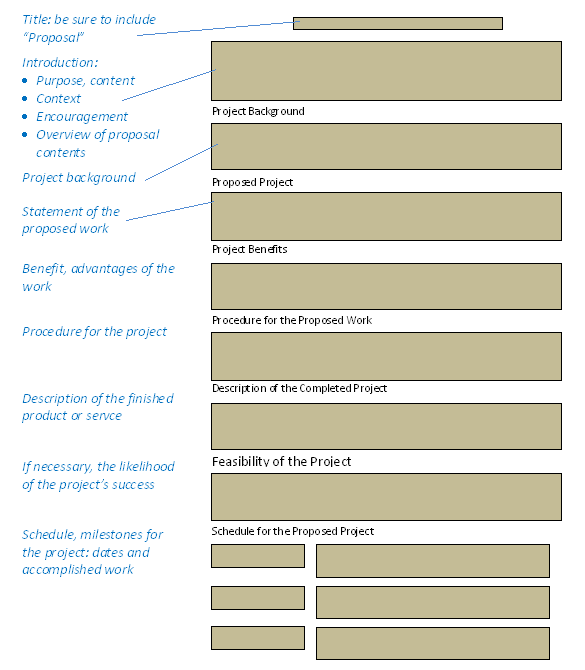
Schematic view of proposals
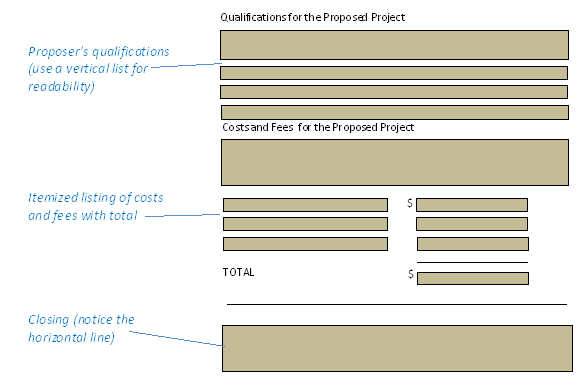
Schematic view of proposals—continued
Description of the proposed work (results of the project). Most proposals must describe the finished product of the proposed project. In a technical writing course, that means describing the written document you propose to write, its audience and purpose; providing an outline; and discussing such things as its length, graphics, binding, and so forth. In the scenario you define, there may be other work such as conducting training seminars or providing an ongoing service. Add that too.
Method, procedure, theory. In some proposals, you'll want to explain how you'll go about doing the proposed work. This acts as an additional persuasive element; it shows the audience you have a sound, well-thought-out approach to the project. Also, it serves as the other form of background some proposals need. Remember that the background section (the one discussed above) focused on the problem or need that brings about the proposal. However, in this section, you discuss the technical background relating to the procedures or technology you plan to use in the proposed work. For example, in the forestry proposal, the writer gives a bit of background on how timber management is done. Once again, this gives you the proposal writer a chance to show that you know what you are talking about and to build confidence in the audience.
Schedule. Most proposals contain a section that shows not only the projected completion date but also key milestones for the project. If you are doing a large project spreading over many months, the timeline would also show dates on which you would deliver progress reports. And if you can't cite specific dates, cite amounts of time for each phase of the project.
Qualifications. Most proposals contain a summary of the proposing individual's or organization's qualifications to do the proposed work. It's like a mini-resume contained in the proposal. The proposal audience uses it to decide whether you are suited for the project. Therefore, this section lists work experience, similar projects, references, training, and education that shows familiarity with the project.
Costs, resources required. Most proposals also contain a section detailing the costs of the project, whether internal or external. With external projects, you may need to list your hourly rates, projected hours, costs of equipment and supplies, and so forth, and then calculate the total cost of the complete project. Internal projects of course are not free, but you should still list the project costs: for example, hours you will need to complete the project, equipment and supplies you'll be using, assistance from other people in the organization, and so on.
Conclusions. The final paragraph or section of the proposal should bring readers back to a focus on the positive aspects of the project (you've just showed them the costs). In the final section, you can end by urging them to get in touch to work out the details of the project, to remind them of the benefits of doing the project, and maybe to put in one last plug for you or your organization as the right choice for the project.
Special project-specific sections. Remember that the preceding sections are typical or common in written proposals, not absolute requirements. Always ask yourself what else might my audience need to understand the project, the need for it, the benefits arising from it, my role in it, my qualifications to it. What else might my readers need to be convinced to allow me to do the project? What else do they need to see in order to approve the project and to approve me to do the project?
Organization of Proposals
As for the organization of the content of a proposal, remember that it is essentially a sales, or promotional kind of thing. Here are the basic steps it goes through:
- You introduce the proposal, telling the readers its purpose and contents.
- You present the background—the problem, opportunity, or situation that brings about the proposed project. Get the reader concerned about the problem, excited about the opportunity, or interested in the situation.
- State what you propose to do about the problem, how you plan to help the readers take advantage of the opportunity, how you intend to help them with the situation.
- Discuss the benefits of doing the proposed project, the advantages that come from approving it.
- Describe exactly what the completed project would consist of, what it would look like, how it would work—describe the results of the project.
- Discuss the method and theory or approach behind that method—enable readers to understand how you'll go about the proposed work.
- Provide a schedule, including major milestones or checkpoints in the project.
- Briefly list your qualifications for the project; provide a mini-resume of the background you have that makes you right for the project.
- Now (and only now), list the costs of the project, the resources you'll need to do the project.
- Conclude with a review of the benefits of doing the project (in case the shock from the costs section was too much), and urge the audience to get in touch or to accept the proposal.
Notice the overall logic of the movement through these section: you get them concerned about a problem or interested in an opportunity, then you get them excited about how you'll fix the problem or do the project, then you show them what good qualifications you have—then hit them with the costs, but then come right back to the good points about the project.
Format of Proposals
You have the following options for the format and packaging of your proposal. It does not matter which you use as long as you use the memorandum format for internal proposals and the business-letter format for external proposals.
- Cover letter or memo with separate proposal: In this format, you write a brief "cover" letter or memo and attach the proposal proper after it. The cover letter or memo briefly announces that a proposal follows and outlines the contents of it. In fact, the contents of the cover letter or memo are pretty much the same as the introduction (discussed in the previous section). Notice, however, that the introduction to the proposal proper that follows the cover letter or memo repeats much of what preceded. This is because the letter or memo may get detached from the proposal or the recipient may not even bother to look at the letter or memo and just dive right into the proposal itself.
- Consolidated business-letter or memo proposal: In this format, you consolidate the entire proposal with a standard business letter or memo. You include headings and other special formatting elements as if it were a report. (This consolidated memo format is illustrated in the left portion of the following illustration.)
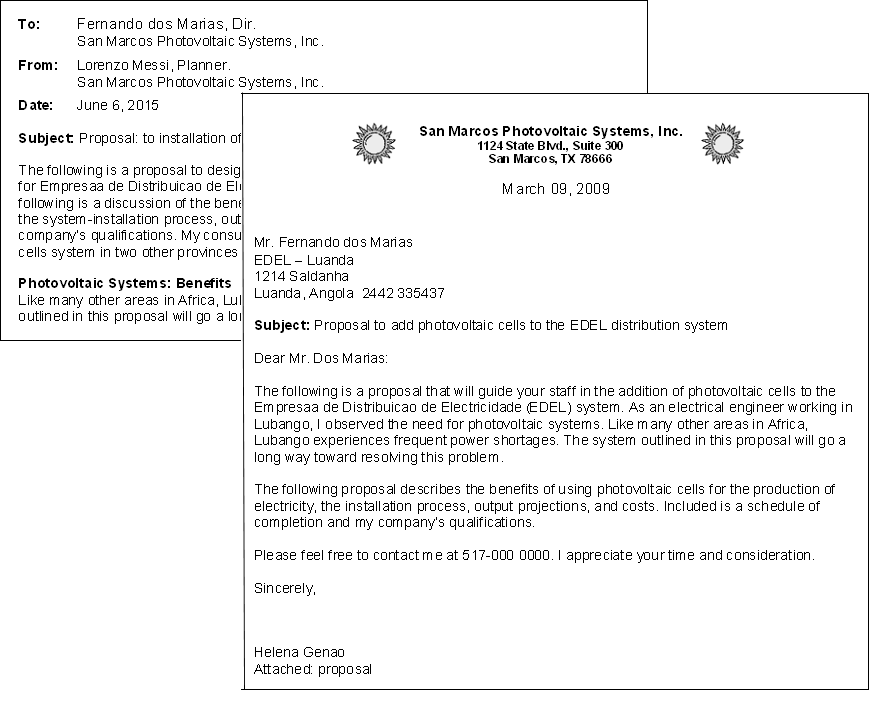
Proposal that uses the consolidated memo format (left) and a proposal that is separate from its cover letter (right)
Special Assignment Requirements
Remember that, in a technical writing course, the proposal assignment serves several purposes: (1) to give you some experience in writing a proposal; (2) to get you started planning your term report; (3) to give your instructor a chance to work with you on your report project, to make sure you've got something workable. For the second and third reasons, you need to include certain specific contents in (or with) your proposal, some of which may not seem appropriate in a real-world proposal. If it doesn't fit in the proposal proper, put it in a memo to your instructor as is done in first example proposal listed at the beginning of this chapter.
Here's a checklist of what to include somewhere in the proposal or in an attached memo to the instructor:
- Audience: Describe the audience of the proposal and the proposed report (they may be different) in terms of the organization they work for, their titles and jobs, their technical background, their ability to understand the report you propose to write.
- Situation: Describe the intended audience of the proposal: who they are, what they do, what their level of knowledge and background on the proposal topic is. Describe the situation in which the proposal is written and in which the project is needed: what problems or needs are there? who has them, where are they located?
- Report type: Explain what type of report you intend to write: is it a technical background report? a feasibility report? Provide enough explanation so that your instructor can see that you understand the type of report. See the chapter on types of reports.
- Information sources: List information sources; make sure you know that there is adequate information for your topic; list specific books, articles, reference works, other kinds of sources that you think will contribute to your report.
- Graphics: List the graphics you think your report will need according to their type and their content. (If you can't think of any your report would need, you may not have a good topic—do some brainstorming with your instructor.)
- Outline: Include an outline of the topics and subtopics you think you'll cover in your report.
AI Prompts for Proposals
Checklists, which typically go unread, can be used as source for AI prompts with some modification. Copy the following, paste it into an AI system such as Google's Gemini, and see what you may have missed.
Note: All references to the content, format, style of techdocs or its components can be found in the online techncial-writing textbook.
coming soon!
Related Information
Write a Winning Request for Proposal.... Kate Eby, smartsheet.com
Secrets to Writing Requests for Proposal That Get Results. clickhelp.com
Request for Proposals. Template, smartsheet.com
How to write a business proposal (The modern way). Yauhen Zaremba, PandaDoc
I would appreciate your thoughts, reactions, criticism regarding this chapter: your response—David McMurrey.
